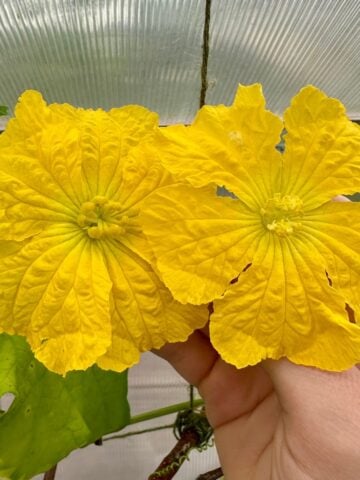A staple of the south, collard greens have been enjoyed by many for generations. Although this plant may seem to be a southern thing they do great in a variety of climates. Collard greens are healthy, tasty, fun, and easy to grow. So let's learn how to grow collard greens.

| Botanical Name | Brassica oleracea |
| Plant Type | Greens |
| Sun Exposure | Full sun to partial shade |
| Soil Conditions | Fertile well drained soil |
| Harvest Time | 60-80 days after planting |
| Difficulty | Easy, Medium, Hard, Extreme |
Where can I grow collard greens
Collard greens can do well with cool and mild temperatures. They enjoy temperatures from 45oF to 85oF degrees, but can survive temperatures as low as 26oF.
These plants are amazing as early spring greens and late fall greens (especially since they handle the frost so well). Collard greens are a truly versatile plant.
When and where should I start my collard greens
For early spring plantings I have had great success starting my seeds in the greenhouse. This gives them a head start and I can get past the season that is full of bugs.
You could start them in indoors under a grow light or even in a cold frame. While it is not necessary to start them and then transplant (like tomatoes and peppers) they do have better success this way.

Since they are able take temperatures down to 26oF I can start mine in an unheated greenhouse. It stays just a few degrees warmer than the outdoors. I have had seed trays freeze all the way through and the collards still make it through.
Where to transplant my collard green starts
Collard greens enjoy both full sun or partial shade. I like to grow most of my greens where they will get some shade because this makes them taste sweeter.
I plant my collard greens in my lasagna garden that is partially shaded by the apple trees. The apple trees offer what I would call dappled shade.

You could also plant them under a trellis where they can stay cooler for the summer time. You can maximize your garden space by growing them under a cucumber trellis.
Good plants for companion plants are marigolds, garlic, celery, and onions. Most of these plants help to keep the unwanted bugs away and attract beneficial insects.
How to transplant them
Simply squeeze your pot while holding it upside down until the little plant plops out. Then use your trowel to dig a small hole.
Gently lower your plant in the hole with the stem buried a little deeper than it was in the pot. Cover back up with the soil and water well.
Spacing requirements
Collards can get rather large and should be planted at least one foot apart. I plant mine in a zig zag pattern to maximize my planting area. You could also alternate your rows to make the most of your garden.

How to fertilize collard greens
Collards do enjoy some good fertilizer in the soil to help them grow big leaves that are sweet and juicy. To fertilize my collard greens I use natural fertilizers like fish emulsions, Epsom salts, and compost tea.
I will also side dress with compost later in the season. I only fertilize my collard greens when I notice that they need a good boost from things like drought, heat, or damage.
How much to water collard greens
Collards, like all greens, do need water for leaves that are not woody, bitter, or dry. Keeping the soil moist, but not soaked, is a good rule of thumb to follow for collard greens.

Planting them densely or under a little shade will help hold in the moisture. You should also mulch around your plants to hold the water in and prevent soil splashing. Mulching also helps build soil life.
When to harvest collard greens
While there is no set date when collard greens are "ripe", they do have a certain point they need to reach before being harvested.
Collard greens are ready to cut when they are around 60 days old. When you harvest them use scissors to cut the large lower leaves. Make sure to leave enough of the center and upper leaves growing.

This will allow you to have many harvests from a single plant. This is what is called a cut and come again technique.
Collard green pests and diseases
While I have not run into any diseases that effect my collard greens I have run into pest issues. One of my pests issues is cabbage moths.
Cabbage moths love to munch on my big juicy collard greens. To take care of these cabbage moths here are a few things you can do (these tactics should work on other pests as well):
- Transplant early in the spring: At this time of year there are less pests out that will effect your collards. This allows your plants to get growing strong before they are eaten by pests.
- Companion plant: Planting your collards next to onions, garlic, and marigolds can help deter the pests while inviting beneficial insects.
- Diatomaceous Earth: A natural pesticide that bugs are not able to build a resistance to. Once you notice that you have bugs simply dust your plants and the bugs will die.
Collard green recipes
I love to eat my collard greens sautéed fresh from the garden. They taste so good! Here are some great recipes to try.
Simple Garlic Sauteed Collard Greens: Note: this article shows cutting the center stem out by making a cut on either side of the stem. I have found it easier and faster to fold the leaf in half and make one cut to remove the stem.
Southern Collard Greens Recipe: This is a truly southern style way to cook collard greens.
Pin This!






Leave a Reply